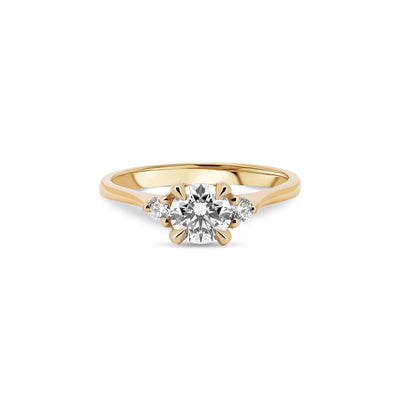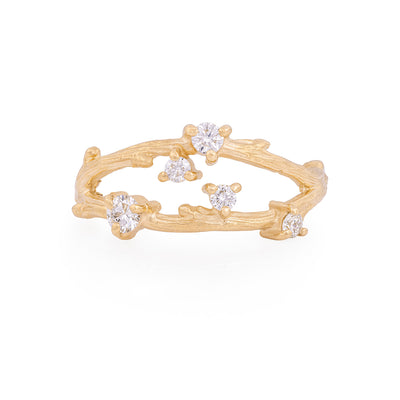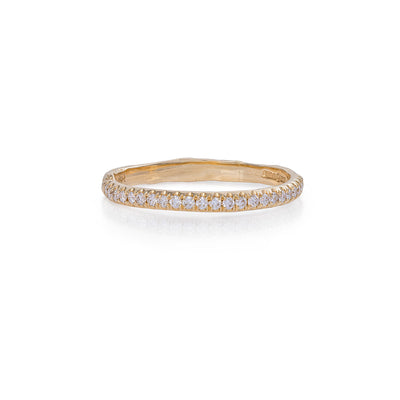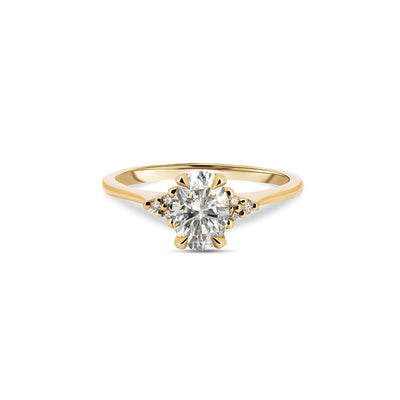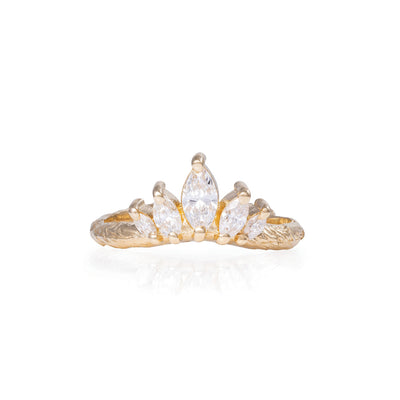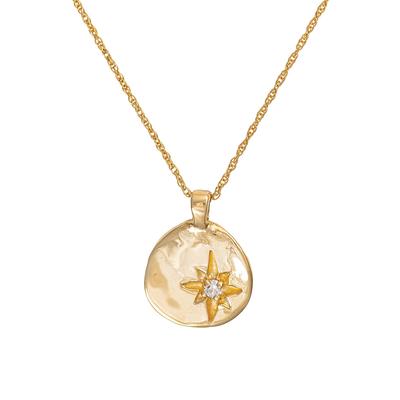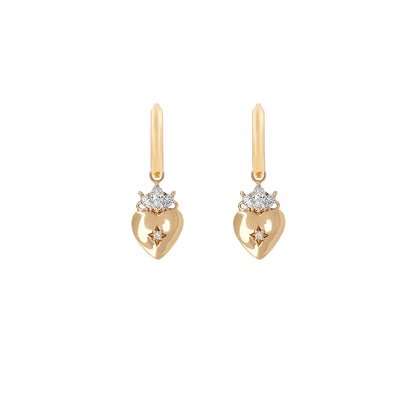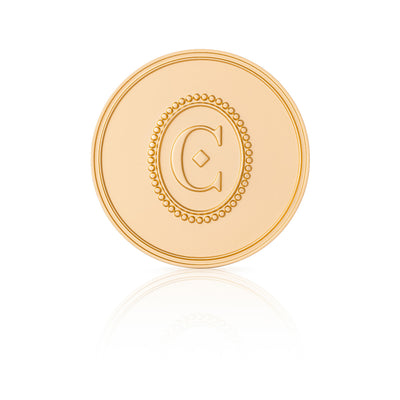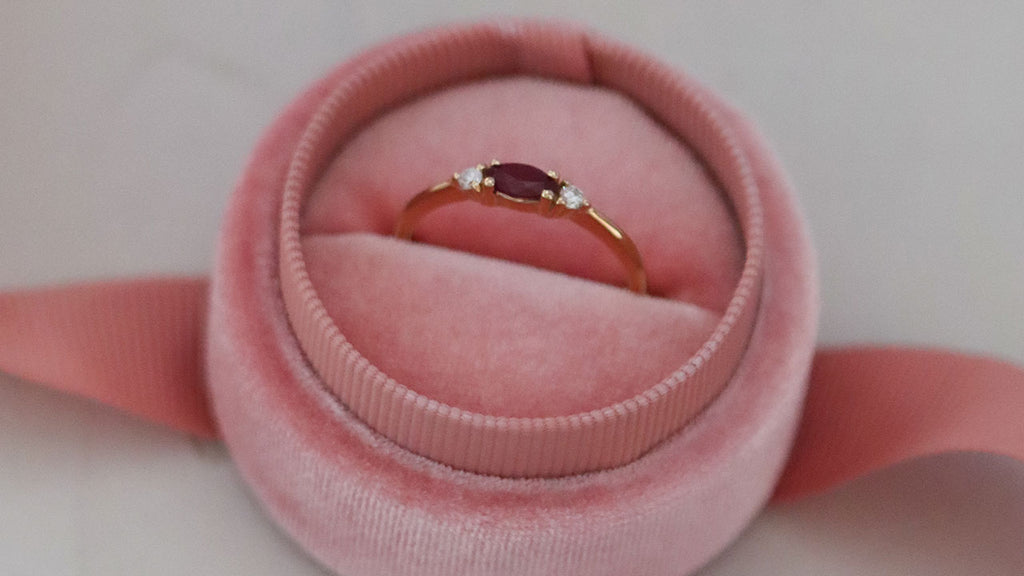"The ruby and the sunrise are one,” wrote the poet Rumi. We love the fiery romance of this beautiful, radiant gem. July is ruby month, so what better way to celebrate than by launching ruby as the newest piece in our Evil Eye collection?
Long associated with power, passion, love and wealth, rubies have been revered since ancient times and have a rich and fascinating history – here are just a few fun facts.

We still don’t know how rubies are made
Even though rubies are mentioned in ancient texts around the world, exactly how they can form remains somewhat of a mystery to this day.
Rubies are made of corundum – incidentally, sapphires are also made of corundum, making the two stones identical other than for their colour (this means pink corundum is sometimes called a ‘pink sapphire’ or a ‘pink ruby’, depending on where you are and who you ask).
While traces of titanium and iron produce sapphire’s stunning blue hue, trace amounts of the mineral chromium are what gives rubies their distinctive colour.
However, this isn’t possible if silica or large amounts of iron are present – which is what baffles scientists, as both are so abundant in the Earth’s crust. Geoscientist Peter Heaney, a professor at Penn State University, even went so far as to say that the fact that rubies exist at all is a “minor geological miracle.”


Rubies have been objects of desire as long as jewellery has existed
Almost as hard as diamonds (a 9 on the Mohs scale to a diamond’s 10), rubies have been treasured and prized since ancient times, and they were worn by both Indian and Southeast Asian royalty for generations.
In the ancient language of Sanskrit, ruby was called ratnaraj, or “king of precious stones”. Rubies are mentioned four times in the bible, and they can even be found listed in Roman scholar Pliny’s texts, dating back to the first century AD.
Records suggest they were even traded along China’s North Silk Road as early as 200 BC.

The most expensive coloured gemstone ever sold is a ruby
With a long history and association with royalty that spans generations and geography, it’s no surprise that rare rubies command massive sums when sold.
The Sunrise Ruby, a 25-carat beauty considered to be among the rarest of all gemstones, made headlines by becoming the most expensive precious gem that is not a diamond to ever be sold when it was purchased in 2015 by an anonymous bidder for a record US$30.42 million.
“Often called “the stone of the heart”, rubies’ association with romance, passion and prosperity goes way back. Medieval Europeans wore rubies to bring wealth, wisdom and success in love and they went on to become extremely popular amongst royalty, often featured in coronation rings and crowns”
Rubies are surrounded by myths and legends
With a name that comes from the Latin word ruber, meaning ‘red’it’s no surprise that all sorts of fiery myths surrounded the gemstones. It was said a ruby could boil water, or cause a fire to never go out or even that rubies contained drops of Mother Earth’s blood.
In the middle ages, rubies were thought to help protect the wearer, especially during battle, but also against everything from lightning and tempests to sadness and jealousy. Some warriors even embedded the gemstone directly in their skin.
In ancient Indian culture, owning a ruby was said to ensure wealth, success and long life.

Ruby slippers really existed (just not on Dorothy)
In The Wizard of Oz, Dorothy’s iconic ruby slippers stole the show – since then, tens of millions of people have viewed them on display at the American History Museum. But of course, they weren’t covered with real rubies, but hundreds of tiny red sequins.
The original ruby slipper owner was Thibaw Min, the last king of the Konbaung Dynasty of Burma (present-day Myanmar) in the 19th century.
His country produced a vast amount of rubies, and he added them to crowns, ceremonial robes and yes, even shoes. His craftsmen are said to have created slippers with a ‘genie-like curl’ in the toe that were encrusted with raw-cut polished rubies.
Rubies are symbols of life, love and power
Often called “the stone of the heart”, rubies' association with romance, passion and prosperity goes way back. Medieval Europeans wore rubies to bring wealth, wisdom and success in love and they went on to become extremely popular amongst royalty, often featured in coronation rings and crowns.
Famously, the Imperial State Crown of Britain displays a Black Prince’s Ruby at its centre, which ironically isn’t a ruby at all, but a red spinel.
More recently, they’ve become popular romantic gifts, with some of the most famous being the Cartier set that Mike Todd gifted to Dame Elizabeth Taylor.

They glow (yes, really)
Sweep a UV light over rubies and they will emit a stunning, otherworldly glow. The chromium responsible for their distinctive red colour gives them a natural red fluorescence that is stimulated by ultraviolet light – sometimes they even look like they’re glowing when the sun hits them, which no doubt inspired these beautiful lines by Rumi:
“I am like a ruby held up to the sunrise.
Is it still a stone, or a world
made of redness?”
Romance, magic, poetry and lore, the fiery ruby has it all in spades.
The newest piece in our talismanic Evil Eye collection is a striking, fiery ruby, the gemstone of July, perfect worn alone or as part of your signature stack.
